Do you learn visually? Or are you better with hearing something explained in depth and then trying it? Or would you rather just figure out how to do something new through trial and error? Or perhaps you’d like to read the user guide and then give it a go?
Each of these examples showcases a different learning style or preference. Different people have different preferences when it comes to learning new things—and your employees are no exception.
Crafting employee training and development materials in a way that incorporates various learning styles can be beneficial and help more employees grasp new ideas faster and retain them better.
Accommodating Different Employee Learning Styles
The catch becomes: How does an employer accommodate varied learning styles while trying to streamline training to make it most efficient for all?
The short answer is to incorporate components of all learning styles into training whenever possible and make that combined style available to everyone rather than trying to create different methods or versions.
Here are some ideas:
- While providing reading material is important, break it up with other options. Keep the reading material available for those who prefer it (and to have it for future reference), but have options for those who don’t absorb information as well simply from reading it.
- Incorporate visual aids like graphs and illustrations into written materials. This can help those who are more visual really understand a concept or process.
- During live presentations, incorporate things like videos or interactive sessions.
- When conducting live training sessions, include time for trying a new program or process. This can help those who prefer hands-on learning get the most out of the training. For others, it can help them put what they’ve read or heard about into context.
- When providing videos, include both voice-over and captions. These can address more than one learning style.
- Train the trainers. If your training managers are not already training experts, give them guidance on adult learning styles and how to accommodate these differences.
- Don’t be too quick to judge someone who does not understand a new task or process quickly if it was only presented in one way. Pay attention to cues that may indicate the person would learn better through other methods. Also, remember that learning style is just one component; everyone has his or her own pace, too.
- Train the trainers to be aware of their own preferences; they may assume others want to learn the same way and use it as a default, which may not be most effective for every audience.
- Encourage questions, which lets those who learn better through explanations hear more details.
- Consider adding live demonstrations whenever applicable, which can help both those who are visual learners and those who learn by doing.
While many people have a definite preference when it comes to learning, they are also likely to use a combination. This can make incorporating many styles doubly beneficial.
What other methods has your organization used to incorporate different learning styles into your employee training and development programs?
Bridget Miller is a business consultant with a specialized MBA in International Economics and Management, which provides a unique perspective on business challenges. She’s been working in the corporate world for over 15 years, with experience across multiple diverse departments including HR, sales, marketing, IT, commercial development, and training.

